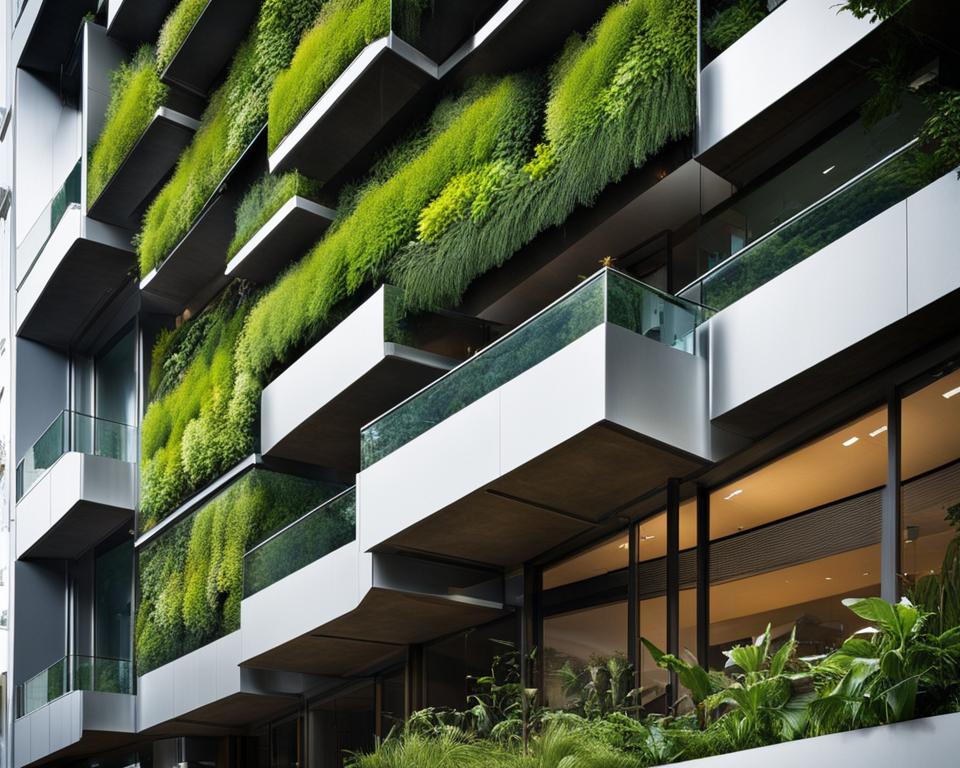Greetings! As an avid gardener with a passion for green spaces, I am thrilled to share with you the art of mastering vertical gardening systems building for urban spaces. In this article, we will explore the wonders of vertical gardening, its benefits, and practical tips for building your own green paradise in the heart of the city. So, grab your green thumb and let’s dive in!
Key Takeaways:
- Vertical gardening is a popular trend in urban planning and personal horticulture.
- It involves using vertical space to grow plants and create greenery in limited urban areas.
- Types of vertical gardens include living walls, green facades, tower gardens, and modular systems.
- Vertical gardens offer benefits such as space-saving, air purification, aesthetic appeal, heat insulation, and biodiversity.
- To start your own vertical garden, choose a suitable location, select appropriate plants, plan the structure and watering system, and ensure regular maintenance.
The Concept of Vertical Gardening
Vertical gardening is a fascinating concept that has gained popularity in recent years, especially in urban spaces. It involves utilizing vertical space to grow plants, transforming walls, balconies, and other vertical surfaces into lush green spaces. This innovative approach to gardening allows individuals with limited outdoor space to cultivate their own little green haven.
One of the distinguishing features of modern vertical gardening is the use of advanced techniques such as hydroponics and aeroponics. Hydroponics is a soil-less method of growing plants, where the roots are immersed in nutrient-rich water, while aeroponics involves growing plants in an air or mist environment, with the roots suspended in air and sprayed with nutrient-rich mist. These systems allow for optimal nutrient absorption and water efficiency, making them ideal for vertical gardens in urban environments.
Vertical gardening is not just about aesthetics; it’s about practicality and sustainability. By utilizing hydroponics and aeroponics, vertical gardens can maximize yield, save water, and reduce the need for pesticides. It’s a testament to how innovation and technology can revolutionize the way we grow plants in urban spaces.
Another aspect of vertical gardening is the use of modular planting systems, which allow for flexibility and customization. These systems consist of stackable containers that can be easily mounted on walls or frames. They provide a convenient solution for growing a variety of plants in small spaces and can be easily rearranged or expanded as needed.
The concept of vertical gardening also embraces automatic irrigation systems, which further enhance the efficiency and ease of maintenance. These systems ensure that plants receive the right amount of water at the right time, reducing the risk of over or under watering. They can be programmable, allowing for precise control of watering schedules and optimizing resource usage.
The Benefits of Vertical Gardening
Vertical gardening offers numerous benefits, making it an attractive option for urban dwellers. First and foremost, it maximizes the use of limited space, allowing individuals to create a green oasis even in the smallest urban areas. Whether it’s a balcony, a rooftop, or a courtyard, vertical gardening transforms unused vertical surfaces into vibrant spaces filled with life.
In addition to space-saving, vertical gardens also contribute to air purification by absorbing carbon dioxide and releasing oxygen, helping to improve air quality in urban environments. They can act as natural insulators, reducing the heat absorbed by buildings and thereby lowering energy usage for cooling.
Furthermore, vertical gardens add a touch of natural beauty to urban landscapes, enhancing aesthetic appeal and creating a sense of tranquility. They also provide habitat for birds, bees, and other pollinators, promoting urban biodiversity and contributing to the overall ecological balance.
As urbanization continues to grow, vertical gardening represents a sustainable and innovative solution for bringing greenery into our cities. Its practicality, aesthetic appeal, and eco-friendly nature make it an ideal choice for urban dwellers looking to connect with nature and create a sustainable living environment.
Types of Vertical Gardens
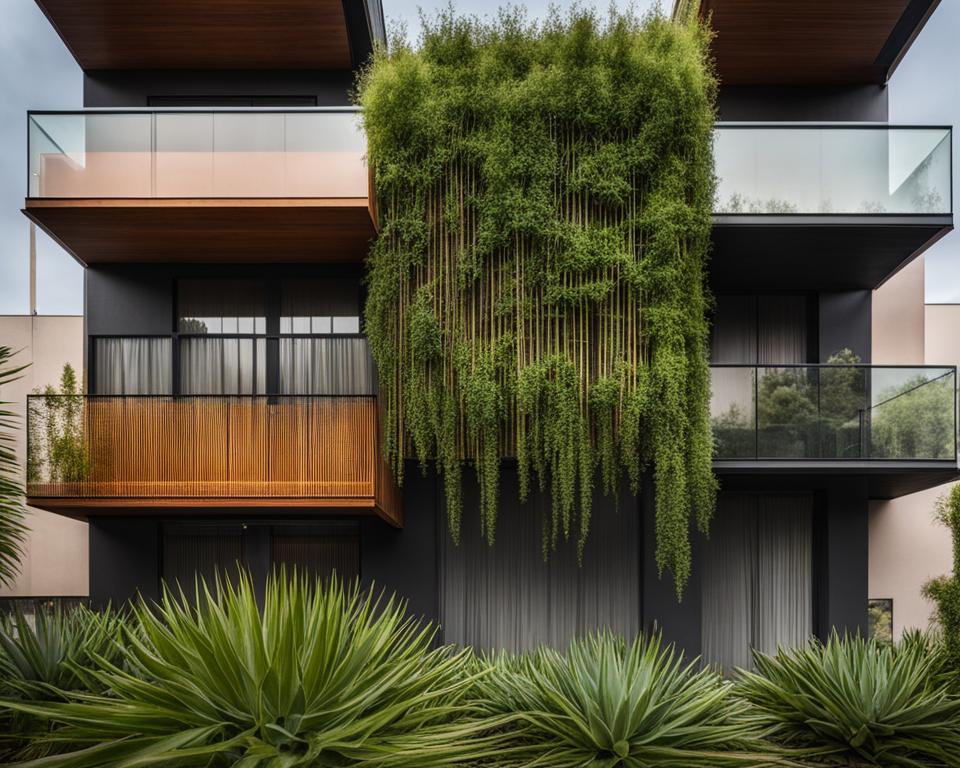
When it comes to vertical gardens, there are various options to choose from based on your preferences and space availability. Here, we will explore four popular types of vertical gardens: living walls, green facades, tower gardens, and modular systems.
Living Walls
A living wall, also known as a green wall, is a vertical garden where plants are rooted directly into a structure or container attached to a wall. This type of vertical garden can be partially or fully covered with plants, creating a beautiful and vibrant display of greenery. Living walls not only add aesthetics to any space but also provide benefits like air purification and temperature regulation.
Green Facades
A green facade is a unique way to incorporate plants into vertical spaces. Climbing plants are strategically planted at the base of a wall and trained to grow upwards, covering the surface with foliage. Green facades not only enhance the visual appeal of buildings but also provide insulation, reducing energy consumption and improving the overall environmental impact.
Tower Gardens
Tower gardens are vertical gardens that allow multiple plants to grow within a vertical column. These self-contained systems are compact and perfect for limited spaces. With a tower garden, you can grow a variety of herbs, vegetables, and even flowers without taking up much floor space. They are an excellent option for urban gardening enthusiasts who want to maximize the yield in a small area.
Modular Systems
Modular systems are versatile and customizable vertical garden solutions. These systems consist of stackable containers that can be easily mounted on walls or placed in frames or brackets. With modular systems, you have the freedom to design your vertical garden according to your preferences and available space. They offer flexibility and can be easily maintained and rearranged as needed.
In conclusion, vertical gardening opens up a world of possibilities for urban dwellers who want to bring greenery into their limited spaces. Whether you opt for a living wall, a green facade, a tower garden, or a modular system, each type of vertical garden has its own unique benefits and aesthetics. Consider your space, preferences, and maintenance capabilities when choosing the right type of vertical garden for your urban oasis.
Benefits of Vertical Gardens
Vertical gardens offer a multitude of benefits that make them a popular choice for urban spaces. One of the key advantages is their space-saving capability. By utilizing vertical space, these gardens maximize the use of limited areas, allowing individuals to grow a variety of plants even in small urban environments. This is especially beneficial for those in apartments or homes with limited outdoor space.
Another significant benefit of vertical gardens is their ability to purify the air. Plants naturally absorb carbon dioxide and release oxygen, helping to improve air quality. Vertical gardens effectively remove toxins from the environment, creating a healthier and more breathable atmosphere. This is particularly valuable in densely populated urban areas where air pollution is a concern.
In addition to their practical advantages, vertical gardens also add aesthetic appeal to urban spaces. The lush greenery and vibrant colors of these gardens create a visually pleasing environment, enhancing the beauty of any setting. Whether it’s a living wall, a tower garden, or a green facade, the presence of vertical gardens brings a touch of nature to urban landscapes, making them more inviting and enjoyable.
Furthermore, vertical gardens provide insulation against heat. The plants act as natural barriers, reducing the temperature of buildings and surrounding areas by providing shade and evaporative cooling. This helps to create a more comfortable microclimate and can contribute to energy savings by reducing the need for excessive air conditioning.
Biodiversity
Lastly, vertical gardens promote urban biodiversity. By creating habitats for various plant species, these gardens attract birds, bees, butterflies, and other beneficial insects. This biodiversity is essential for maintaining a healthy ecosystem and can contribute to the pollination of surrounding plants. Vertical gardens play an active role in preserving and enhancing urban biodiversity, creating a harmonious balance between nature and urban living.
| Benefits of Vertical Gardens |
|---|
| Space-saving capability |
| Air purification |
| Aesthetic appeal |
| Heat insulation |
| Biodiversity |
How to Start Your Own Vertical Garden
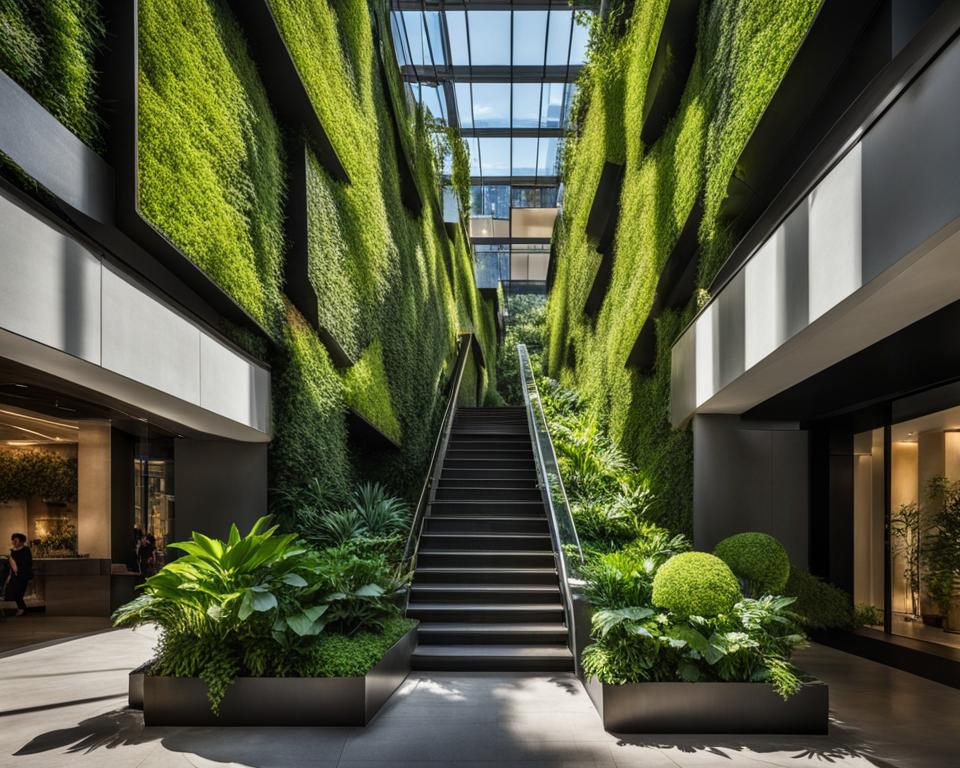
Starting your own vertical garden is an exciting and rewarding endeavor that allows you to bring nature into your urban space. To successfully embark on this green journey, there are several key considerations to keep in mind:
1. Location:
Choose a location for your vertical garden that receives adequate sunlight or has access to artificial lighting. Most plants require at least 6 hours of direct sunlight each day to thrive. Consider the orientation of your space and the amount of light it receives to ensure the health and growth of your plants.
2. Plant Selection:
Select plants that are suitable for your climate and that fit the care requirements of your vertical garden. Some popular plant choices for vertical gardens include herbs, flowers, succulents, and leafy greens. Consider the available space and the growth habits of your chosen plants to ensure they can be accommodated in your vertical garden system.
3. Structure and System:
Choose the type of vertical garden structure that best suits your needs and space limitations. Living walls, tower gardens, and modular systems are popular options. Determine whether you want a soil-based system or a hydroponic system, which uses a nutrient-rich water solution instead of soil. Ensure your chosen structure and system provide adequate support, drainage, and irrigation for your plants.
4. Watering and Nutrients:
Plan an efficient watering system for your vertical garden. Consider using a drip irrigation system or self-watering containers to ensure consistent moisture levels. Regularly monitor the moisture content of the soil or growing medium and adjust your watering schedule as needed. Additionally, provide your plants with the necessary nutrients by incorporating organic fertilizers or hydroponic nutrient solutions into your maintenance routine.
5. Maintenance:
Maintaining your vertical garden is essential for its long-term success. Regularly inspect your plants for signs of pests or diseases, and take appropriate measures to control and prevent any issues. Trim and prune your plants as needed to maintain their shape and ensure optimal growth. Keep your vertical garden clean by removing any debris or dead plant material. Finally, stay consistent with your watering and fertilizing routine to keep your plants healthy and thriving.
By following these steps, you can create a flourishing vertical garden in your urban space. Enjoy the beauty and benefits of nature right at your fingertips!
Expanded Benefits of Vertical Gardens
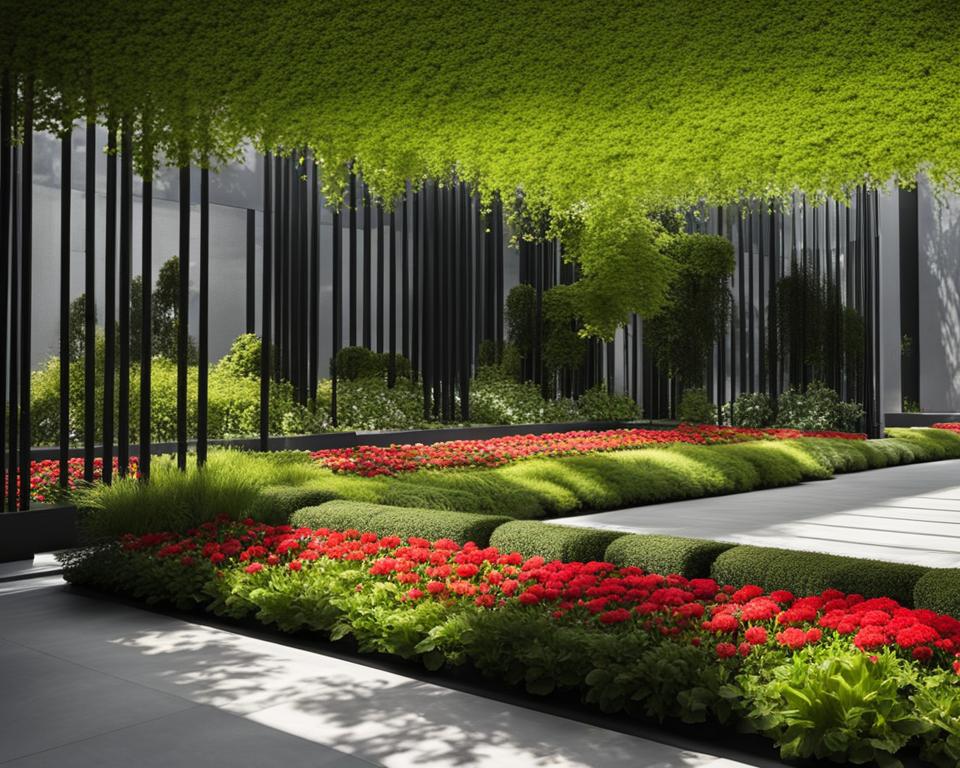
Vertical gardens offer a wide range of benefits beyond their primary advantages. These green spaces in urban environments have been found to have significant mental health advantages. Studies have shown that spending time in nature and interacting with plants can reduce stress, anxiety, and depression, promoting overall well-being. Vertical gardens provide residents of urban areas with an opportunity to connect with nature and improve their mental health.
Another advantage of vertical gardens is their ability to reduce noise pollution. The dense vegetation in these gardens acts as a natural sound barrier, absorbing and diffusing sound waves. This can be particularly beneficial for individuals living in busy urban areas or near noisy roadways, creating a more peaceful and tranquil environment.
Vertical gardens also have a positive economic impact. They increase property values by enhancing the aesthetic appeal of buildings and public spaces. The presence of lush greenery can attract potential buyers or tenants and contribute to a sense of community pride. Additionally, vertical gardens can provide employment opportunities, such as garden maintenance and construction, further boosting the local economy.
Furthermore, vertical gardens serve as valuable educational tools for communities. They offer hands-on learning opportunities for individuals of all ages, teaching them about the importance of environmental sustainability, plant care, and urban farming. Schools, community centers, and even businesses can incorporate vertical gardens into their educational programs, fostering a greater understanding and appreciation for nature and gardening.
Table: Comparing the Benefits of Vertical Gardens
| Benefits | Vertical Gardens | Traditional Gardens |
|---|---|---|
| Space-saving | ✔️ | ❌ |
| Noise reduction | ✔️ | ❌ |
| Economic impact | ✔️ | ❌ |
| Educational opportunities | ✔️ | ❌ |
Advanced Techniques in Vertical Gardening
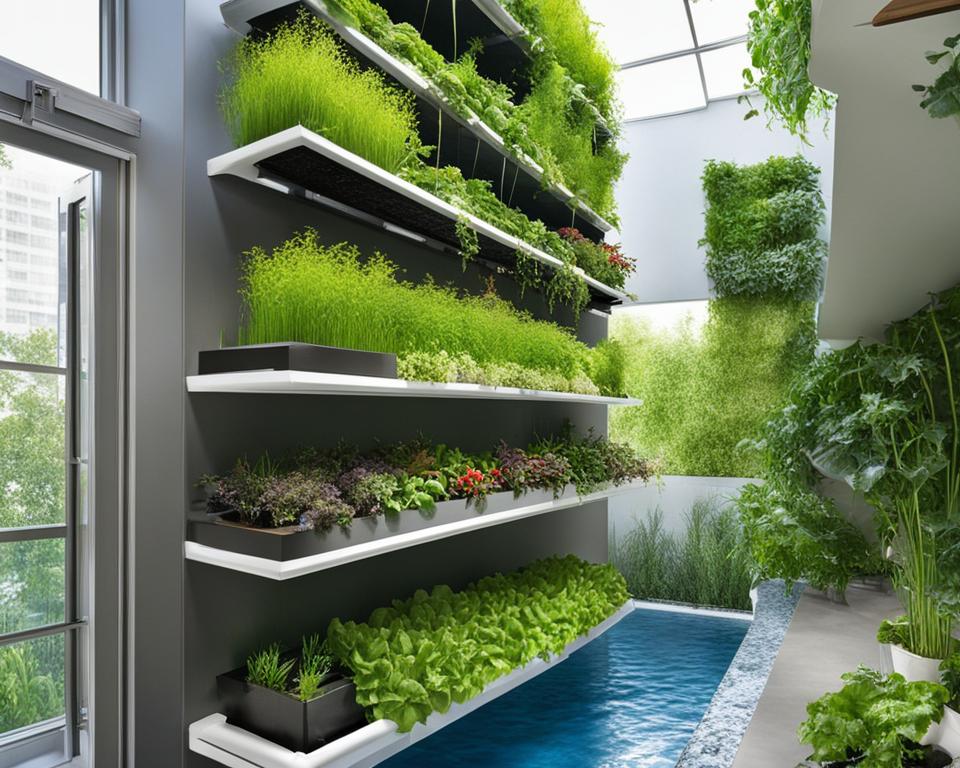
As vertical gardening continues to evolve, innovative techniques are being implemented to enhance productivity, efficiency, and sustainability. With the integration of IoT technology, aquaponic systems, and rotating towers, vertical gardens are reaching new heights of sophistication.
IoT Integration
The integration of Internet of Things (IoT) technology in vertical gardens has revolutionized the way plants are cared for. IoT allows for automated monitoring and control of vital factors such as temperature, humidity, and lighting. With the help of sensors and actuators, vertical gardens can adjust environmental conditions in real-time, ensuring optimal growth and minimizing water and energy consumption.
Aquaponic Systems
Aquaponic systems combine hydroponics with aquaculture to create a mutually beneficial relationship between fish and plants. In these systems, the waste produced by fish is converted into nutrients that nourish the plants, while the plants filter and clean the water for the fish. Aquaponics eliminates the need for traditional fertilizers and reduces water usage, making it a sustainable and efficient method for vertical gardening.
Rotating Towers
Rotating towers are an innovative approach to vertical gardening that ensures plants receive consistent exposure to light and air. These towers rotate at specific intervals, allowing each plant to receive an equal amount of sunlight and preventing shading issues. The rotation also promotes even growth and reduces the risk of pests and diseases by improving air circulation within the vertical garden.
With these advanced techniques, vertical gardens are becoming more efficient, productive, and environmentally friendly. The integration of IoT technology enables precise control of environmental conditions, aquaponic systems provide sustainable nutrient management, and rotating towers ensure optimal plant growth. These advancements not only benefit urban spaces with limited land availability but also contribute to the overall well-being of our communities.
The Community Impact of Vertical Gardens
Vertical gardens offer more than just aesthetic appeal and environmental benefits. They have a profound impact on communities, promoting social cohesion, public installations, and urban farming.
One of the key ways vertical gardens impact communities is through public installations. These green spaces create a sense of unity and pride among residents. They serve as focal points for community gatherings, art installations, and events. Vertical gardens can transform a dull urban space into a vibrant oasis that inspires and engages people of all ages.
Vertical gardens also foster social cohesion by creating opportunities for people to connect with one another. Whether it’s a community gardening project or a shared interest in sustainable living, vertical gardens bring people together in a common goal. By working together to maintain and care for these green spaces, individuals strengthen their bonds and build stronger, more connected communities.
Another important aspect of vertical gardens is their role in urban farming. These gardens provide a source of fresh, locally grown produce in areas where access to fresh food may be limited. Urban farming not only contributes to food security but also promotes healthy eating habits and sustainable agriculture practices. It empowers communities to take control of their food sources and reduces their reliance on outside resources.
| Public Installations | Social Cohesion | Urban Farming |
|---|---|---|
| Creates vibrant, engaging spaces | Brings people together in a common goal | Provides fresh, locally grown produce |
| Hosts community events and gatherings | Strengthens community connections | Promotes healthy eating habits |
| Inspires and engages people of all ages | Builds stronger, more connected communities | Reduces reliance on outside food sources |
Vertical gardens have the potential to transform not only physical spaces but also the social fabric of communities. By incorporating these green installations in urban areas, we can create a more sustainable, harmonious, and connected future for all.
Conclusion
Vertical gardening is a game-changer for urban living. It offers an innovative and sustainable solution to maximize limited spaces and bring nature into our cities. With the rapid growth of urbanization, vertical gardens are becoming essential in creating green havens amidst concrete jungles.
By embracing vertical gardening, we can foster a harmonious blend of aesthetics, sustainability, and community. These gardens not only enhance the visual appeal of urban spaces but also improve the quality of life for residents. They provide an opportunity for individuals to reconnect with nature and experience the benefits of a green environment.
As technology advances, vertical gardening continues to evolve. It’s an exciting time for innovation in this field, with the integration of IoT systems, aquaponics, and rotating towers. These advancements enhance the efficiency and functionality of vertical gardens, making them even more accessible and effective.
The future of urban gardening is filled with growth and possibilities. Let’s join the revolution and embrace vertical gardening. Whether it’s in our homes or public spaces, we can contribute to the urban greening movement and create a positive impact on our surroundings. Together, we can cultivate a greener, healthier, and more sustainable future.
FAQ
What is vertical gardening?
Vertical gardening involves using vertical space to grow plants and create greenery in limited urban areas. It maximizes space by utilizing techniques like hydroponics and aeroponics, modular planting systems, and automatic irrigation.
What are the different types of vertical gardens?
There are several types of vertical gardens, including living walls, green facades, tower gardens, and modular systems. Living walls are partially or wholly covered with plants rooted in the structure or in modular containers. Green facades use climbing plants anchored to a wall, while tower gardens allow multiple plants to grow in a vertical column. Modular systems are stackable containers that can fit into customized wall brackets or frames.
What are the benefits of vertical gardens?
Vertical gardens offer numerous benefits, such as maximizing space in limited urban areas, purifying the air by removing toxins, providing aesthetic appeal, acting as heat insulation, and promoting urban biodiversity.
How can I start my own vertical garden?
To start your own vertical garden, choose a location with adequate sunlight or artificial lighting, select suitable plants based on climate and care requirements, decide on the type of vertical garden structure, plan an efficient watering system, and ensure regular maintenance.
What are some additional benefits of vertical gardens?
In addition to the primary benefits, vertical gardens also improve mental health by providing green spaces in urban environments, reduce noise pollution, increase property value, and serve as educational tools for communities.
Are there advanced techniques in vertical gardening?
Yes, advanced vertical gardens incorporate IoT technology for efficient watering and lighting systems, utilize aquaponics for a symbiotic relationship between fish and plants, and employ rotating towers for consistent light and air exposure.
How do vertical gardens impact communities?
Vertical gardens enhance public spaces with installations, foster social interaction and educational opportunities, and promote local food production through urban farming, positively impacting communities.

